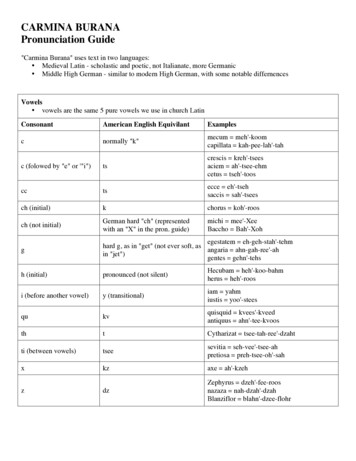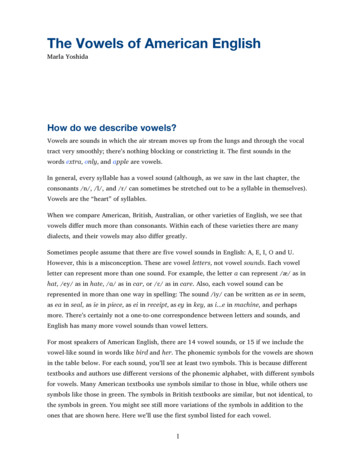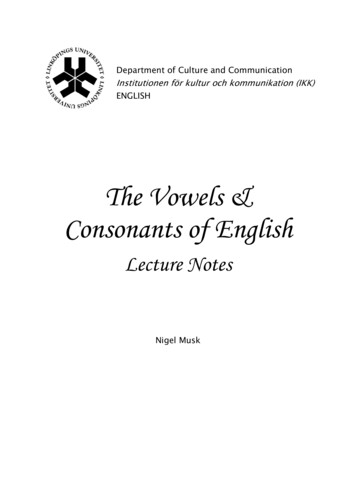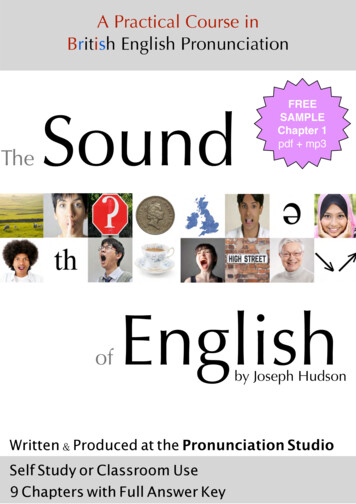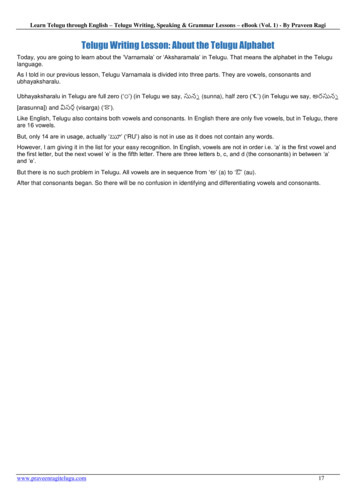
Transcription
English VowelsChing Kang LiuNational Taipei u.tw/ ckliu/pronunciation/pronunciation.htm1
OverviewHow much time for each language skillAccording to Burley-Allen (1995), the averagetime spent on basic skills during the dailycommunication process is35 % for speaking,16 % for reading,9 % for writing, and40 % for listening. (Flowerdew, 2005)How can we polish our different skills in English?2
OverviewA new perspective of EnglishHow to Improve English Vowels3
OverviewDeviating sounds made by EFL studentsEnglishsounds/i/keep; keysDeviatedsounds/ // /ill;/i// /take / hate/ // /red/ // /bad; fast/ // /mother/ // n/run; country/ // /food/ // /good/ // /hope; boat/ /?/ /caught; law/ /ExamplesExamplesSolutionskip; kissDirect methods: audio-visual(multimedia) aids and faceeel;to-face instruction/t k/; tekPhonetic approaches:raid1. The fundamental issues ofbed; festthe vowel space;/ m / 2. The courses/routes of eachvowel phoneme in each/r /;“sound area”;/ k tri/3. The recognition and the/f d/ foot?understanding of the factthat English with different/g d/ goo ?accents might havehop; boughtdifferent qualities of vowelcoat; lowphonemes4
ating sounds made by EFL milardurationsExampleskeykeyskeepSolutionsPhonetic approaches:Provide examples anddemonstrations5
The global picture of the vowel contrastMismatchTypesEnglish /i// // // // // // // // // // // // // // /Mandarin (Pinyin)/ / ㄩNotesmismatch/i/ ㄧmismatch/ei/ ㄟ/(i)e/ ㄝmismatch/e/ ㄜ/a/ ㄚmismatch/ou/ ㄡ/(u)o/ ㄛ/u/ ㄨmismatch/ai/ ㄞ/ao/ ㄠmismatch6
The basic vowel phonemes in the chartVowel spaceEnglish has a total of 12 basic vowel phonemes whileMandarin has only 9 basic vowel phonemes.Compare the following charts:English vowel phonemes Mandarin vowel phonemes (ㄧ) (ㄩ) (ㄨ) (ㄟ) (ㄡ) *Schwa (unstressed vowels) (ㄝ) (ㄜ) (ㄛ) (ㄚ)*zhi(ㄓ),chi(ㄔ), shi(ㄕ), ri(ㄖ), zi(ㄗ),ci(ㄘ),si(ㄙ)7
SpectrogramAcoustic qualities of the vowel0.073240-0.081270.6358421.10658Time (s)500000.6358421.10658Time (s)8
F1The concepts of the first formantFormant 1: reflecting the “high” or “low” of the vowel in the oraltract0.073240-0.081270.6358421.10658Time (s)500040003000F12000100000.6358421.10658Time (s)010009
F2The concepts of the second formantFormant 2: reflecting the “backness” of the vowel in the oraltract0.073240-0.081270.6358421.10658Time (s)500040003000F22000100000.6358421.10658Time (s)3500010
F1An expression with only the first formant5000001.79918Time (s)
F2An expression with only the second formant5000001.80107Time (s)
F3An expression with only the third formant5000001.80768Time (s)
F1, F2, F3An expression with three formants but no F05000002.10842Time (s)
F0, F1, F2,An expression with all formantsF35000002.10397Time (s)
F1/F2The relationship between F1 & F2See also CBCAPArticulatory and acoustic descriptionsSee also PRAATA package of speech analyzer
VowelspaceHow to locate the vowel space using PRAATStep 1: get the software packageStep 2: record sound or download soundStep 3: segment the sound and keep the vowelStep 4: use the “formant & LPC” formatStep 5: draw the scatterplotStep 6: copy and paste the chartDemonstrate PRAAT
VowelspaceTry to scatterplot the following soundsTry to find thefrequencies ofF1 and F2 andlocate the spacefor the followingvowels:heed, hidhade, headlow, law350001500
VowelspaceTry to scatterplot the following soundsheed (F1 420, F2 3082 )hid (F1 615, F2 2437 )hade (F1 539, F2 2741)head (F1 843, F2 2134)35000heedhadehidheadlow (F1 653, F2 1489)law (F1 805, F2 1261)lowlaw1500
Vowel space The vowel space of /i, ε, æ , α, כ , u/ (by an AES)-35000-2800-2100iii i iii iiiii i iiiii iiiiiiiiiiii ii iii i ii ii iii iiiii iiii ii iii ii-300-600-900i-1200-1400u-7000i uuuu uuuuuuaeuuuuuuuuuuuuuuuuuuuuu uuuuu u uuuuu eeeueuue ee e eeeeuueeeeeeeee ueeeeeeee eaaeaeae aaaaa aaeaeaeaaaaaaaeaeaeeee ae aeaeaeaaae aeeeaeaeaaaaeaaaaaeaeaea aaaaaaeaaeaeaeaeaeeeaeaaeaeeea ea aeeeaeaeaeaeaaeaaeaeaaeaeaeaaeaeaaaeeaeae aea aeaaeaeaaaeaeaeaaaaeeaeaaeaeaaeaaeaeaeaeaaeaaeaaa aeaae aeeae aeaa-1500150035000F 2 (Hz)(with the frequency of the first formant on the vertical axis and thefrequencies of the second formant on the horizontal axis)20
Vowel space The VS of /i, ε, æ , α, כ , u/ (by an AES at UCLA)-35000-2800-2100-1400-70000uiiuuii ii iiii ii iiii iiiiuuiiiiii uuiiuuiiuuu u uueeee eeeee eaaaa ea e aaaaeee ae eaaaaa aaaeaaaa ee eeeeaae aeeeeaaeaee 5003500-15000F 2 (Hz)21
Vowel space The VS of /i, ε, æ , α, כ , u/ (by an AusES)3500028002100iiiiiiiieeeeee eee14007000uuuaeuuuu uuu 0uu0uuuuuuu uu uuuuuii i0uuuu00iae000 000000000000aeaeaeaaeaaaaaea aaaaae0 50015000F2 (Hz)(The vowel is extracted from heed, Ed, hat, odd, law, who)22
Vowel space The vowel space of /i, ε, æ , α, כ , u/ (by a MS)350002800ii ii2100iiii1400700000000i00000000000ae000ae00ae0ae0 0aeaeae0000ae00aeaei i i iaeiaeiaeaeaee e e eee eaaee aaaeeeeeeeee eaaaaaea a00300i60090012001500350015000F2 (Hz)(The vowel is extracted from heed, Ed, hat, odd, law, who)23
Vowel space The VS of /i, ε, æ , α, כ , u/ (by another MS)3500028002100140070000300iii ii iiii i i i iuu0u uu uu i uueuuuuuaaaaa 000aaaa 000aaaaaa000ae000e00ae ae00000 0a 00eaeeeeee aee eeeaeaeeeeeee eeeaeaeeeeaeaeaeaeaeaeae aeae ae aeaeaeaeae15003500600900120015000F2 (Hz)(The vowel is extracted from heed, Ed, hat, odd, law, who)24
Vowel space The vowel space of /ーㄝㄚㄛㄨ/ (by a MS)3500028002100140070000i iii iieii ii iei ii iiii i i i i iiiii ieueu uuueee ueeeieeeee i ieiei ee eeeeeeeeeeeeeeeeeeeeee eeeee ee eea e ee eeeeuuuuuauuuuuaa aaaaaaaaaaaaaaaaaaaaa 00350015000F2 (Hz)25
Vowel space Contrasting the charts by an AES and a MS-35000-2800-2100iii i iii iiiii i iiiii iiiiiiiiiiii ii ii i ii ii iii iiiii iiiii ii iii ii-300-600-900i-1200-1400u-700035000i uuuaeuuuuuuuuuuuuuuuuuuuuuuuuuuuuuuuuuuuuuu ee2800ii ieuuuee ee e eeeeuueeeeeeeee ueeeeeeee eaaeaeae aaaaaeaeaaaaaaeaeaa aeee aeaeaeaeaeeeeaeaeaaaaeaaaaaaaeaeaeaeaeaaaaea aaaaeaeaeaeaeeeeaeaaeaeeeeeaeaeaeaeaaeaaeaaeaaeaea aeaeaeaaaeaeaaaeeaaeaeaeaea aeaeaaaeaeaeaaeaeaeaeaeaeaeaeaea aaaeaaaeaaa aeaae aeei2100iiii1400700000000000 000i0000ae00000ae00ae ae0 0aeaeae0000aeae00aei i i iaeiaeiaeaeaee e e eee eaaee aaaeeeaaea aeeeeee eaaa00300i6009001200ae aeaa-150015003500F 2 (Hz)15000 350015000F2 (Hz)26
Vowel space Comparing the charts by two 0-70000uiii i iii iiiii i iiiii iiiiiiiiiiii ii iii i ii ii iii iiiii iiii ii iii ii-300-600-900i-1200ui uuuaeuuuuuuuuuuuuuuuuuuuuuuuuuuuuuuuuuuuuuuu eeii ii ii iiuuii ii iiii iiiiuuiiiiii uuuiiuiiuuuuuuuuuuu u euuuuuuuuuuuuiiiiiiiiiiiu-300iiiiuu-600euuuee eee e eeeuueeeeeeeee ueeeeeeee eaaeaeaaaa aaeaeaeaeaaaaaaaaeaeaeeeeaeaeaeaaae aeeeaeaeaaaaeaaeaaaaeaeaeaaaaea aaaaeaeaeeeaeaeaeeea ea aaeaeaeaaaeaeaeaaeaeaaeaeaaeaaeaeaeaeaeaaeaaeaaa aeaae aeeeuuuueeeee eeeee eaaaa ea e aaaeeeeaaaaaa aeeeee eeae aaaaa aaaaeeaae aeeeae aeaeaeaeaeaeaeaeaeaeae aeaeaeaeaeaeaeaeu-900-1200uae aeaa-1500150035000F 2 (Hz)15003500-15000F 2 (Hz)27
Vowel space The charts produced by an ES & a MS28
Vowel space The charts produced by two ESs29
Movement How to detect the vowel movement?500040003000The spectrogram of2000“food” by an EFL1000student001.10644Time (s)u3500 3000 2500 2000 1500 10005000The course of /u/0200in “food” by an EFL400student600800100012001400u
Movement How to detect the vowel 655350004000400030003000200020001000100000The spectrogram of“food” by a nativespeaker00.936553Time (s)u3000200010000The course of /u/ in0“food” by a nativespeaker300600u90012001500
Movement How to detect the vowel 40004000300030002000200010001000000.749243The spectrogram of“food” by a nativespeaker00.936553Time (s)The spectrogram of5000“food” by an EFLstudent4000300020001000001.10644Time (s)
Movement How to detect the vowel movement?5000The spectrogram of/u/ in “coo” by anEFL student400030002000100000350030001.10649uTime (s)25002000150010005000The course of /u / in“coo” by an EFLstudent0300600u90012001500
Movement How to detect the vowel movement?5000The spectrogram of/u/ in “coo” by anative speaker4000300020001000000.86449Time (s)u3500300025002000150010005000The course of /u / in“coo” by a nativespeaker0300600u90012001500
Movement Contrasting the vowel movements of /u/The spectrogram of“coo” by a nativespeakerThe spectrogram of“coo” by an S90012001500MS2
DirectionsHow to specify the courses of the soundHeed (BrE, male)0.09650-0.193200.581769Time (s)50004000300020001000000.581769Time (s)Hid (BrE, male)0.23160-0.256700.501451Time (s)50004000300020001000000.501451Time (s)
DirectionsHow to specify the courses of the soundheedF2 HzhidF1 HzF2 2Heed2000200F1 Hz(BrE, 0200Hid250(BrE, male)300350400450500hid
DirectionsThe vowel directions of EnglishesAmE (male)3000250020001500BrE 000NZE who'dhood800hidhadehadeNTPU thutment1000
DirectionsContrasting heed and hidAmE (male) heed vs. hid30002500200015001000500BrE (male) heed vs. headhead400lowlaw600600hadhot800hutment1000NZE (male) heed vs. 00lowlawwho'dhood800hidhadehadeNTPU (male) heed vs. 000who'dhoodhadhotlowlawhood800hidhothutment1000
DirectionsContrasting hade and headAmE (male) hade vs. head30002500200015001000500BrE (male) hade vs. 0headhead400lowlaw600600hadhot800hutment1000NZE (male) hade vs. 000lowlawwho'dhood800hidhadehadeNTPU (male) hade vs. 1000who'dhoodhadhotlowlawhood800hidhothutment1000
DirectionsContrasting low and law (considered a tense-lax pair here)AmE (male) low vs. law30002500200015001000500BrE (male) low vs. headhead400lowlaw600600hadhot800hutment1000NZE (male) low vs. 00lowlawwho'dhood800hidhadehadeNTPU (male) low vs. 000who'dhoodhadhotlowlawhood800hidhothutment1000
Tense/laxMechanism in the English phonemic systemi / /
movements Mapping the physical locationsLocating the “vowel space” and get the true qualities of thevowel of American English
Movements Using Accent Coach to identify the vowelsTry to pronounce the following vowels:/ :, ; , ; ; ; , ; , :/i / /
Vowels/i/MRI graphs of oral tracts for vowelsFrontBack/ /45
VowelsMRI graphs of oral tracts for vowels/ // /46
VowelsMRI graphs of oral tracts for vowels/o//u/47
ContrastThe pair feet/fitKK symbols: /i/ & / /1. feet/fit/i/ / /My feet don’t fit48
ContrastPractice: pairs of /i/ & / / 03 The vowel /i/ 05 The vowel / eedeatbeatdeepteethfeetSentences:1. He sees the key point.2. Please leave me tences:1. This kid is sick; he isshivering.2. Give him six minutes tofinish the quiz.49
Practice“eat” vs. “it” [ ] [ ] i key [ ] [ ] iskeysitkeep leadkiss kidleaflibseelipContrast /i/ and / / (key)1. isease2. iteat3. diddeed4. dipdeep5. shipsheepSentences:1. At least you can give me a list.2. I know you live here, but you must leave tomorrow.3. The sheep are on the ship now.
ContrastThe pair food/footKK symbols: / / & / /4. food/foot/ / / /Don’t put the food near your foot.51
ContrastPractice: pairs of / / & / / 19 The vowel /u/ 20 The vowel / bemoodoopsbootflutetoothmootSentences:1. Sue bought a new suit.2. Which will you choose:food or kSentences:1. He looks like a goodcook.2. A good-looking womanwants to buy the book.52
Practice“food” vs. “foot” [ ] [ ] good could took shook book put [ ] [u] goose cooloose lose food bootContrast the vowels / / and /u/1. bookboot2. pullpool3. footfood4. tooktool5. goodgooseSentences:1. You need to choose a good cookbook.2. The food looks good. Can you put it in my room?
ContrastThe pair let/lateKK symbols: / / & / /2. let/late/ / / /He is late. Don’t let him in.54
ContrastPractice: pairs of / / & / / 07 The vowel / / 08 The vowel chfetchSentences:1. The weather there isgreat.2. The red pepper does notsell well in the etakecakeSentences:1. They played all day.2. What’s your name? Areyou James?55
Practice“late” vs. “let” [ ] [e ] [ ] [ ] saybetsagebedsake mayless legContrast /e/ and / / (hate)1. ageedge2. badebed3. matemet4. waitwet5. wastewestSentences:1. I met my roommate yesterday.2. Put the pepper on the paper.makeredmadewreck
ContrastThe pair bought/boatKK symbols: / / & / /3. bought/boat He bought a boat yesterday./ / / /57
ContrastPractice: pairs of / / & / / 16 The vowel / / 17 The vowel boughtdaughtertaughtcaughtSentences:1. You ought to sit in andaudit the course.2. He bought some chalkfor his daughter.ohbow tSentences:1. This is an old showabout a goat.2. He told me that it wascold outside and gaveme the coat.58
Practice“low” vs. “law” [ ] [ ] caught cause law saw [ ] [ ] nonose note boatbought allhopehoseContrast / / and /o/1. oatought2. boatbought3. posepause4. lawlow5. coatcaughtSentences:1. He bought a new boat last week.2. He showed me the original copy of Shaw’s notebook.
ContrastThe pair bought/boatKK symbols: / / & / /5. said/sad/ / / /He said his dad was very sad.60
ContrastPractice: pairs of / / & / / 10 The vowel / / apSentences:1. I’m not mad, but I’m sad.2. I’m glad that Jack isback.Contrast / / and / /XbeddeadleftguessaxbaddadlaughedgasSentences:1. I guess the fire wascaused by gas.2. The dragon had twoheads.3. He said he was sad.61
Practice“bed” vs. “bad” [ ] [ ] [ ] [ ] betbadbedbatlessbagContrast / / and / /1. Xax2. bedbad3. deaddad4. leftlaughed5. guessgasSentences:1. I guess the fire was caused by gas.2. The dragon had two heads.3. He said he was sad.legred wreckback batch badge
Practice“lock” vs. “luck” [ ] [ ] gotgodnodnotoddop[ ] ugly upbudloveluckmud much[ ]study trouble double mother brother governmentcountryContrast the vowels / / and / /1. upop (operation)2. duckdock3. bucksbox4. lucklock5. gutgotSentences:1. The government seems to be bothered by some kind oftrouble.2. Shut the door, or you’ll be shot.
PracticeThe vowels followed by an /r/ sound[ ]earyearbeernear hear volunteer[ ]airbearpairfairdare sharechair[ ] irebyrefireliardiredesireretire[ ]birdverbperch firstwork wormword[ ]actor doctor letter better
PracticeThe minimal pairs in the contextA1. At least you can give me a list.2. I know you live here, but you must leave tomorrow.B1. I met my roommate yesterday.2. Put the pepper on the paper.C1. I guess the fire was caused by gas.2. The dragon had two heads.3. He said he was sad.D1. The government seems to be bothered by some kind of trouble.2. Shut the door, or you’ll be shot.E1. He bought a new boat last week.2. He showed me the original copy of Shaw’s work.F1. You need to choose a good cookbook.2. The food looks good. Can you put it in my room?
Practice The minimal pairs in the context1. We ran in the rain on Sunday noon.2. He bought a boat and put it on the cold shore.3. The caterpillar lived on the leaf.4. The woman cooked food for the two poor tourists.5. We love to lie down and look at the sky at night.6. I want you to take it easy and don’t make me hate you.7. His mother was lucky enough and won another new cup.8. My dad was sad when I packed my bag.
VowelsRules for English vowel allophones1. A given vowel is longest in an open syllable, next longest in asyllable closed by a voiced consonant, and shortest in a syllableclosed by a voiceless consonant.(key)2. Other things being equal, vowels are longer in stressedsyllables.3. Other things being equal, vowels are longest in monosyllabicwords, next longest in words with two syllables, and shortest inwords with more than two syllables.speedspeedyspeedily67
VowelsRules for English vowel allophones4. A reduced vowel may be voiceless when it occurs after avoiceless stop (and before a voiceless stop).permission, tomato, compare, potato, catastrophepreparatory, introduction, replicate, complicate5. Vowels are nasalized in syllables closed by a nasal consonant.ban, run, seen6. Vowels are retracted before syllable final [ ].peel, pail, pal68
PracticeThe vowels in the contextGood evening, ladies and gentleman, and welcome. I’m sure we have all heard theexpression, “Think Green.” Tonight we are going to talk about ways that we can “Act Green” inour everyday lives.The best place to start, of course, is in the home. Every day, people all over the worldare hurting the environment without even knowing it. For example, busy families buy papernapkins and plastic food wrap at the supermarket. This helps them save time on housework,but after these things have been used, what happens to them? They go in the trash. In manyplaces, especially in North America, big cities are running out of places to throw their trash.Shouldn’t we do something about this before it’s too late?American EnglishBritish EnglishAustralian EnglishSouth African EnglishNew Zealand EnglishIrish EnglishSaint KittsNTPU
AccentsThe vowel movements of different accents1. British[ ], [ ]; [ ], [ ]; [ ]; [ ]; [ ], [ ]; [ ], [ ][ ], [ ]; [ ], [ ]; [ ]; [ ]; [ ], [ ]; [ ], [ ]2. Australian[ ], [ ]; [ ], [ ]; [ ]; [ ]; [ ], [ ]; [ ], [ ][ ], [ ]; [ ], [ ]; [ ]; [ ]; [ ], [ ]; [ ], [ ]3. South Africa[ ], [ ]; [ ], [ ]; [ ]; [ ]; [ ], [ ]; [ ], [ ][ ], [ ]; [ ], [ ]; [ ]; [ ]; [ ], [ ]; [ ], [ ]4. New Zealand[ ], [ ]; [ ], [ ]; [ ]; [ ]; [ ], [ ]; [ ], [ ]5. Irish[ ], [ ]; [ ], [ ]; [ ]; [ ]; [ ], [ ]; [ ], [ ]6. Saint Kitts[ ], [ ]; [ ], [ ]; [ ]; [ ]; [ ], [ ]; [ ], [ ]70
The EndOf the vowel sectionThank you!71
English NextDavid Graddol, 2006 (pp. 107-8)It would be interesting tospeculate on what that‘saturation point’, or final‘market penetration’ of Englishmight be. At this stage, veryrough estimates based on theemerging patterns of middleclass and urbanisation hint ataround 3 billion speakers byaround 2040. In other words, itis doubtful whether, even if the‘World English Project’ weresuccessfully implemented, thatmore than around 40% of theglobal population would everbecome functional users ofEnglish.72
English NextDavid Graddol, 2006 (pp. 90-91)73
English NextDavid Graddol, 2006 (pp. 90-91) 74
The EndComments and suggestions, please!Thank you!75
English sounds Examples Deviated sounds Examples Solutions /i/ keep; keys / / kip; kiss Direct methods: audio-visual (multimedia) aids and face-to-face instruction Phonetic approaches: 1. The fundamental issues of the vowel space; 2. The courses/routes of each vowel
